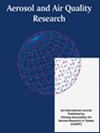Synergistic Effect of Multi-field Force on Condensable Particulate Matter Properties and Behavior in Flue Gas: A Case Study in a Municipal Solid Waste Incineration Plan
IF 2.5
4区 环境科学与生态学
Q3 ENVIRONMENTAL SCIENCES
引用次数: 1
Abstract
At present, filterable particulate matter (FPM) emissions from stable source flue gases are well controlled, and the more difficult to remove condensable particulate matter (CPM) has received much attention due to its environmental hazards. In this study, we built a cold electrode electrostatic precipitator (CE-ESP) and systematically investigated the removal efficiency of CPM from municipal solid waste incineration plant flue gas by CE-ESP under three different operating modes. The results showed that hydrocarbons, esters and aromatic compounds were the main organic substances in CPM. The CE-ESP had a significant contribution to the removal of SO 42– , F – , Al, Ni, Cr, and Pb from CPM. In contrast, it had a less effective removal of NO 3– and Ca in CPM. The CE-ESP was effective for removing esters in CPM. The removal efficiency of CE-ESP for CPM could reach 76%, and the removal efficiency of organic substance was higher than that of inorganic substance. It is demonstrated that the combination of thermophoretic force and electric field in CE-ESP intensifies the turbulent agglomeration process, and the diffusion force generated by the concentration field synergistically enhances the interparticle coagulation and agglomeration. This promotes the homogeneous condensation process of CPM and the heterogeneous condensation of CPM and FPM, which is conducive to the reduction of condensable particulate matter in flue gas and can provide a theoretical basis for practical application in engineering多场力对烟气中可冷凝颗粒物特性和行为的协同效应——以某城市生活垃圾焚烧计划为例
目前,稳定源烟气中可过滤颗粒物(FPM)的排放得到了很好的控制,而较难去除的可冷凝颗粒物(CPM)因其对环境的危害而备受关注。本研究搭建了冷电极静电除尘器(CE-ESP),系统考察了CE-ESP在三种不同运行模式下对城市生活垃圾焚烧厂烟气中CPM的去除效果。结果表明,CPM的主要有机成分为烃类、酯类和芳香族化合物。CE-ESP对CPM中so42 -、F -、Al、Ni、Cr和Pb的去除效果显著。相比之下,它对CPM中的no3 -和Ca的去除效果较差。CE-ESP对CPM中的酯类具有较好的去除效果。CE-ESP对CPM的去除率可达76%,对有机物的去除率高于无机物。结果表明,CE-ESP中热电泳力和电场的结合强化了湍流团聚过程,浓度场产生的扩散力协同增强了颗粒间的凝聚和团聚。这促进了CPM的均相冷凝过程以及CPM与FPM的非均相冷凝过程,有利于减少烟气中可冷凝颗粒物,可为工程实际应用提供理论依据
本文章由计算机程序翻译,如有差异,请以英文原文为准。
求助全文
约1分钟内获得全文
求助全文
来源期刊

Aerosol and Air Quality Research
ENVIRONMENTAL SCIENCES-
CiteScore
8.30
自引率
10.00%
发文量
163
审稿时长
3 months
期刊介绍:
The international journal of Aerosol and Air Quality Research (AAQR) covers all aspects of aerosol science and technology, atmospheric science and air quality related issues. It encompasses a multi-disciplinary field, including:
- Aerosol, air quality, atmospheric chemistry and global change;
- Air toxics (hazardous air pollutants (HAPs), persistent organic pollutants (POPs)) - Sources, control, transport and fate, human exposure;
- Nanoparticle and nanotechnology;
- Sources, combustion, thermal decomposition, emission, properties, behavior, formation, transport, deposition, measurement and analysis;
- Effects on the environments;
- Air quality and human health;
- Bioaerosols;
- Indoor air quality;
- Energy and air pollution;
- Pollution control technologies;
- Invention and improvement of sampling instruments and technologies;
- Optical/radiative properties and remote sensing;
- Carbon dioxide emission, capture, storage and utilization; novel methods for the reduction of carbon dioxide emission;
- Other topics related to aerosol and air quality.
 求助内容:
求助内容: 应助结果提醒方式:
应助结果提醒方式:


